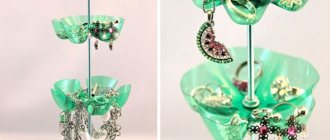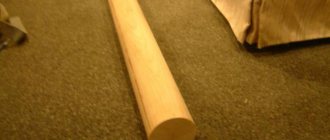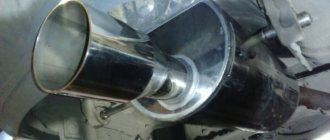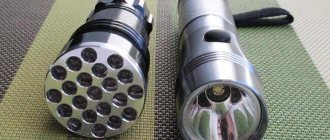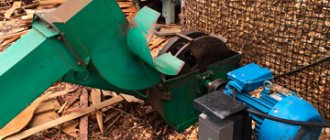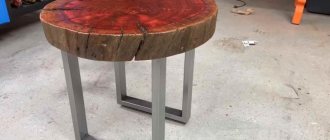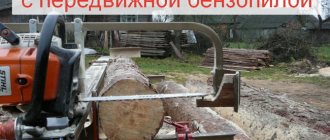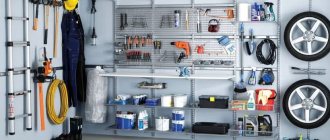The plastic recycling process begins with thorough washing and drying.
To do this, you can use a bucket, basin, or do it in the bath. You can wash with warm water, but it is recommended to use a soap solution. Important! If the plastic is not washed well, there may be a lot of smoke when melting.
Then you need to sort. To melt a house without harm to health, it is best to use only plastic marked “2”, “02” in a triangle, or simply the inscription HDPE.
Before grinding, you must remove the lid and the protective ring attached to the neck. They are made from a different type of plastic and are recycled separately.
What is the purpose and functions of the press in everyday life and its varieties
Such devices have a very wide range of applications.
This can be not only squeezing out various parts, but also a device for a walk-behind tractor that collects hay and lays it in even rolls. Perhaps the manufacture of some durable concrete products is required, or perhaps a lot of sawdust has accumulated, from which good fuel can be made. Let's look at the main jobs that the press can perform in everyday life. This equipment can be divided into several types. The design of some types is similar, while others have fundamental design differences.
The simplest table press
Press for extruding parts from any base or shell
Such equipment will come in handy in garage conditions. It is not profitable for an ordinary motorist to purchase it, because... the cost is quite high, and they rarely perform the work. But making a press for the garage with your own hands at minimal cost is quite acceptable.
You can use a similar press for silent blocks or bearings, i.e. for those parts whose installation and dismantling cannot be done manually. Having spent a little time, you can design and assemble a device, the cost of which in a store can exceed 50,000 rubles.
Wooden press for making fuel briquettes
Device for compacting various materials into dense briquettes
Such a device will help put old newspapers into use, which will make good fuel for the stove. A waste paper press will help you save on purchasing coal or firewood. In addition, the need to dispose of unnecessary correspondence, of which many have accumulated a huge amount, disappears.
Approximately the same principle can be used to make a sawdust press. The excellent fuel that will be obtained when using it has proven itself well not only in stove heating, but even on vacation. Long burning, intense heat and lack of smoke – these are the advantages that helped fuel briquettes made using a press gain popularity. Shish kebab, barbecue or a hot fire with minimal flame - what else is needed for a good rest?
And this is a schematic representation of it
There is another option to compress coal chips instead of sawdust. In this case, it will be a fuel that burns for a very long time and produces a huge amount of heat. And there is usually a lot of such crumble in the coal sheds of houses that are heated with it. So why not put him into action?
Press for recycling plastic and cardboard
Surely many have seen cardboard boxes that are tightly compressed into a tight stack. This is also the work of the press. After all, it is much more convenient to export such material when it is compactly packaged. A cardboard press is one of the easiest to make with your own hands. Other solid materials can be disposed of using approximately the same principle. For example, with the help of a press, plastic bottles are transformed into neat layers that are convenient for transportation.
A mechanical cardboard press is a very convenient device.
But still, pressing plants bring the greatest help in agriculture.
Mechanized harvest assistant
To collect the straw remaining on the field after harvesting, or forage hay, it is optimal to use a homemade pick-up press. Moreover, it will not only make work easier. Straw will be rolled into neat, dense rolls that are convenient to transport and store.
In the drawings of a do-it-yourself hay press, it is necessary to indicate the dimensions - this will help in the end to assemble everything correctly. Although there are options for very simple units, more on that below.
The simplest wooden hay press - minimum material and manufacturing time
Well, for starters, before you start making such a unit yourself, it is important to understand the designs of its various types, understand their differences and decide on the necessary material
What may be needed for recycling
When it comes to recycling plastic bottles at home, associations associated with crafts immediately arise. In addition, you can make raw materials at home for re-production and hand them over to collection points.
Equipment
You don't need any special equipment to recycle plastic at home. This can be done using available tools:
- The plate is suitable for melting the necks and bottoms of PET bottles. Just be sure to use a hood!
- The oven is a good place to bake... HDPE plastic.
- You can make your own device for cutting PET bottles into threads. It allows you to cut large lengths of tape in a short time. The range of its application is very wide, since it is strong, durable and has heat-shrinkable properties.
- To arrange paths in the area in front of the house, forms are needed. You can make them yourself or purchase them ready-made at a hardware store.
Premises requirement
When cutting and shredding plastic at home, there are no special space requirements. However, if remelting is planned, good ventilation will be required. It is not recommended to do this in an apartment, since the kitchen hood usually goes into the general ventilation system. A garage or shed would be more suitable for such work.
Process of recycling plastic waste at home
Shredding PET bottles or other plastic waste
How to cover a roof with roofing felt: useful tips from roofers.
The next stage is more difficult - grinding. Small plastic can be remelted to specialized companies or remelted yourself.
You can crush bottles using a juicer, but this will lead to rapid wear and tear. In addition, too fine a fraction is not always convenient to process. It would be optimal to “dissolve” the bottles into threads and cut them into flakes with scissors.
Melting plastic and casting raw materials into special molds.
HDPE plastic becomes plastic already at a temperature of 180C. Therefore, a conventional oven, both electric and gas, is suitable for melting it. Depending on the volume of material, the “baking” time ranges from 15 minutes to an hour. The shredded plastic pieces are spread on a baking sheet on top of regular parchment paper.
Molding can be carried out slowly; the heated material cools down for a long time and retains its viscous shape. When cooling, it is worth considering that slight shrinkage will occur. To make tiles, you can prepare a mold from wood, or you can simply trim the edges of the cooled “pancake.”
PET bottles are much more difficult to melt. If the temperature regime is not maintained, the plastic will not retain its physical properties. It will cease to be plastic, the mass will become cloudy, and after cooling it will begin to crumble in your hands.
To melt plastic bottles you need a container. Usually they use a tin can or an old, unnecessary pan. To reduce harmful fumes during the melting process, you can add a little vegetable oil. But even in this case, you cannot do without a respirator and good ventilation.
Important! Using containers for cooking after melting plastic in it is strictly prohibited!
The melting point of PET plastic is higher than that of HDPE. It becomes soft at 240C, and at 250C it already melts. It is not recommended to keep it in a molten state for more than two minutes, and when taken out of the oven, you only have 15-20 seconds to pour the liquid plastic into the mold.
When melting it over a fire, the difficulty lies in the temperature difference between the upper and lower layers. In order to somehow equalize the difference, they use a hair dryer.
Products made from remelted PET plastic are pleasant to the touch. Various souvenirs can be smelted from it. Overheated matte plastic resembles the structure of natural onyx stone.
Options for where to dispose of such waste
If you don’t want to risk your health, you can take the collected plastic waste to a recycling collection point. This is the most responsible option for recycling plastic. Almost all cities have such points. Not everywhere they take away only material marked with numbers 3 and 7.
You can also throw your plastic waste into a container designated for plastic. This option is relevant if the locality organizes separate waste disposal with subsequent recycling. In the USA, Western Europe and developed countries of Asia this is par for the course; in Russia there is still a problem with separate collection. In most cases, Russians are forced to throw plastic into common containers, then garbage trucks take the garbage to landfills.
DIY plastic bottle press
How to drill tiles on a wall: detailed instructions and useful tips
Contents In an era when ideas for creating a business are born from scratch, working with various types of plastic waste, for example, bottles, is especially relevant.
They are processed into various products, and sometimes they are simply stopped at the stage of collecting and selling empty used containers.
But in any case, the issue of their transportation and storage remains relevant. A plastic bottle press can help facilitate various manipulations with this bulk container.
You don’t have to buy it, you can make it yourself. Before deciding on the design and, accordingly, the amount of materials needed, you need to understand where the press will stand.
The dimensions of the equipment directly depend on the height of the ceiling in the room. There is no point in making high-power plastic presses yourself, since the price of work and purchased spare parts is almost equal to the cost of an industrial machine.
Advantages of self-assembly:
- saving money: sometimes very relevant, especially in organizing a small business;
- the press is manufactured strictly for its tasks; the size and density of the bale packaging depends on the wishes.
- affordable materials that are available even in the most remote cities;
- there are no costs for transportation and installation of heavy equipment, it is assembled directly on site;
If you have no experience in working with metal and welding, it is better to contact a specialist, since professional workshops have all the necessary tools. Below we will consider the technology for assembling a press for plastic bottles with manual control, but with sufficient loading capacity of up to 30 kg. Here are the main ones:
- The area of the bed is approximately 1 to 1.5 meters.
- Bale or briquette weight. In principle, the amount of loaded material depends directly on the physical capabilities of the operator, how much weight a person can lift in constant operation. This model involves packing a stack of bottles weighing up to 25 kg.
- Electric motor power. It is advisable to install a 380 Volt engine, but 220 Volt is also possible. Power determines the speed of bringing together and spreading the press plates.
- The size of the plates and, consequently, other dimensions depends on the width of the press plates.
- Height is the determining standard size. It depends on the size of the hydraulic cylinder lever. In this version it can vary from 1.5 to 3 meters.
- The size of the bale depends on the size of the slabs. The optimal width is 300-400 mm. Thickness depends on weight. Bottles are not a very convenient material for pressing; they slip and stick out. Therefore, the briquette may look bloated and sloppy.
Here's what you can't do without when creating a press for plastic bottles with your own hands:
Hydraulics unit.
What it will consist of depends on the expected power and dimensions. If it is a mini-press, then just a hydraulic cylinder from a jack is enough. But in this case, the quality of the compressed material will depend on the strength of the operator’s hands, since it does not significantly increase the manual effort.
Agglomerator
Acceptance of plastic bottles for recycling: where can you take PET containers and at what price?
This unit is intended for sintering flex. The cost of the cheapest industrial designs is about two hundred thousand rubles. Therefore, it is not surprising that craftsmen make such units on their own. Of course, it is impossible to manufacture such a unit from scratch without milling and turning. However, you can use the drawing and ask your friends who work at the factory to make the necessary parts.
Many who organize the conversion of plastic bottles in garages and other utility rooms outside the attention of government agencies monitoring compliance with sanitary and environmental standards use existing electric furnaces as the working chamber of the agglomerator, since the flexible begins to sinter at temperatures starting from 180˚C. The most popular are Dave Hakkens agglomerators.
Shredder
This unit is designed for shredding plastic products. The resulting small plates of plastic are called flex. Industrially manufactured devices are quite expensive.
For example, the simplest AMD-200D crusher, which processes about fifty kilograms of feedstock per hour, will cost about one hundred and thirty-five thousand rubles. But making such a unit with your own hands won’t take much work.
Those interested will find the drawings useful:
If conditions permit and it is possible to place baths in the room for washing the resulting flex and a centrifuge for drying, you can limit yourself to its production. Today, according to the Flagma company, such material is sold from thirty-five to forty-nine rubles per kilogram, and bought from twenty to thirty-five rubles per kilogram.
PET collection and recycling business
Visionary entrepreneurs have long seen the advantages of a PET waste recycling business. By purchasing equipment for processing plastic bottles and opening their own mini-factory, they receive sufficient profit.
The recycling business niche currently remains quite empty. The volume of discarded PET waste is only growing from year to year, which means starting a business would be a smart decision.
We should not forget about the authorities who are interested in the cleanliness of the territory under their trust. An entrepreneur can receive various benefits when organizing a business for recycling plastic bottles.
Preferential conditions and subsidies are generally a feature of any business related to recycling.
Sources of raw materials
Even before completing the documents, it is worth solving the problem of finding raw materials.
PET waste collection is carried out in several ways:
- Concluding an agreement with landfills.
- Organization of collection points for PET bottles from citizens for a symbolic fee.
- Installation of containers for plastic bottles within the city.
It would also be a good idea to think through the process of transporting raw materials to the place of storage and processing.
Preparing for the opening
Before registering, you need to choose a form of business based on the planned production volumes: individual entrepreneur or LLC. The type of activity is called processing of non-metallic waste.
The next step is to find premises for the workshop
Here it is worth paying attention to the inexpensive quadrature of the industrial zone. Help from the administration may be useful, as it can help provide a place for recycling.
Necessary equipment
Having decided on the place of production and a convenient form of business, you should worry about purchasing equipment for processing PET containers.
Complete PET bottle recycling line includes:
- A machine that removes caps and labels.
- Conveyor for transportation.
- Shredding apparatus - shredder or crusher.
- Steam installation.
- Automatic polishing machine.
- Washing equipment.
- Dryer.
Recycling cycle
The path that PET bottles take from the moment they arrive at the storage warehouse to the final raw material is as follows:
- Manual sorting of waste by color and pre-cleaning.
- Delivery to the processing line, removal of stickers and covers on the machine.
- Grinding and separation in a crushing plant.
- Placing intermediate raw materials into a steam boiler to remove residual debris.
- Washing and drying of raw materials.
- Package.
The output is purified and ready for sale or subsequent processing.
Starting capital and payback
A business plan for recycling plastic bottles should include the main goal of the business, a detailed structure of the enterprise, ways to approach the goal and possible risks.
In practice, the strategy must take into account all elements of production. There is no need to start the process if the supply channels for raw materials or product sales are not established.
Starting capital largely depends on the region and rental prices.
On average, a business plan and profitability calculation have the following figures:
- Middle segment equipment - 3 million rubles.
- Purchase of raw materials and transportation costs - 35 thousand rubles.
- Payment of wages to employees - 115 thousand rubles/month
- Contributions to pension and other funds, as well as utility costs - about 50 thousand rubles / month
The profit received starts at around 150 thousand. The investment pays off in 18-24 months.
Principles of writing a business plan
Like any other business plan for the organization and operation of an enterprise aimed at processing plastic bottles and other plastic products, it is drawn up in accordance with the requirements for such documents by the reviewing specialists. This must be taken into account, because a business plan is prepared not so much for oneself, but for those who, on its basis, will allocate the money needed to turn the idea into practice. Financial specialists are the most picky. If you yourself don’t know something thoroughly, you will definitely turn to specialists to get an assessment of the proposed document. Therefore, the document being created must comply as much as possible with accepted standards, since, as they say, you meet people by their clothes.
Before writing, you need to clearly understand that a business plan, in essence, is simply a written explanation of the proposed project, the amounts required for its implementation, as well as the optimal time frame for implementation. This approach to the matter will immediately clarify what is main and what is secondary, what needs to be emphasized and what needs to be relegated to the background.
Information about the project of the future enterprise is divided into several sections:
- Section I.
Title page. Here preamble information about the name of the enterprise, its form of ownership and address is posted, the name of the proposed project is posted, telephone numbers and email addresses are posted. The date of preparation of the document is indicated and information is provided on the need to calculate cash costs and profits, which are included in the document or placed in a separate appendix. - Section II.
This section containing copyright information is often referred to as the “Confidentiality Memorandum.” It sets out information about the authors of the business plan materials and their rights, obligations regarding non-disclosure of information received without the author's consent, as well as obligations to return the business plan after reading it if the decision on it is not positive. - Section III.
This section is often called the “Summary”. This section briefly outlines the entire business plan and reveals the essence of the project. It is recommended to create this section after writing the entire business plan and arrange the information following the following structure:
- project description;
- resource provision;
- ways and means of implementation;
- the answer to the question - what is unique about the project;
- required investment amount;
- projected profit;
- ways to return money to investors;
- effectiveness of the proposed project.
- Section IV.
Objective of the project. This section describes the intended purpose of the proposed business, describes the services or goods supplied to the market, indicating the benefits that customers will receive. For this purpose, the advantages of the manufactured products are described in detail. If there is their uniqueness, this moment should be described as carefully and extensively as possible. If the latest technologies are used, it is necessary to indicate how copyright will be implemented. - Section V.
Market analysis in the area of the proposed business. Here the results of marketing research regarding the products offered are presented, and the activities of competitors are analyzed. If, when writing a business plan, there is no uniqueness of the proposed business in a given region, the emphasis is on reducing costs through the use of new technologies, reducing energy costs, personnel, and so on. It is imperative to take into account that today there are practically no areas that are no longer covered by business, therefore, having found competitors, you need to justify why the proposed business is more attractive. - Section VI.
Position of the created enterprise in the industry. Here the main characteristics of the enterprise are described and, based on their analysis, the place of the planned production or trade in the existing industry is noted. The preferred form of ownership of the enterprise is indicated and what costs will have to be incurred to create it. The section also contains information about:
- company address;
- the type of premises required, indicating whether it already exists or needs to be purchased, whether repairs are necessary or not;
- economic performance indicators;
- temporary characteristics of the specifics of production activities.
If the business is planned to be started from scratch, the presence or absence of experience in this area of the proposed management is indicated. The manager’s lack of experience in the proposed field is a very negative characteristic and, as a rule, initiates the refusal of third-party investors.
- Section VII.
Product Description. The section is created after an analysis of the existing market. Based on the analysis, a conclusion is drawn about the advantages of the proposed product and the competitive ability of the company. Product samples or their photos and a description of technical characteristics must be present in this section or attached to it. If several units of a product are produced, each of them is described in detail. Structurally, the section is divided into several subsections:
- the name of the product, as well as its description;
- purpose and areas of use;
- specifications
- competitive advantages;
- presence or absence of copyrights;
- environmental friendliness of the product or lack thereof;
- quality certificates;
- service and operation.
- Section VIII.
Sales of products. The section contains a marketing plan for the sale of the manufactured product. Such a plan should include:
- market behavior patterns;
- reasoned explanation of the quantity of products purchased by customers;
- describes the methods used to influence demand;
- describes the methodology for calculating prices;
- information on methods of sale is provided;
- the legal status of the main consumer is indicated.
Any material on organizing a business includes a governing advice - find the customer. This is what a marketing plan is designed to do. This structural unit is subject to close study, so it is necessary to indicate in detail:
- what criteria for evaluating the product from the consumer’s point of view were studied when writing the business plan;
- what place in the supply chain occupies the client to whom the goods are supplied.
This section is based on the characteristics with which the product is assessed not by the manufacturer, but by the consumer. It is very desirable to provide an analysis of the evaluation of a similar product by competitors’ consumers and, based on this information, justify the attractiveness of your own product. This section also includes the logistics concept - how and to whom the goods are delivered, who is responsible for sending them. A strategy for conducting advertising campaigns is given. Prices and sales volumes are indicated by time periods. Payback periods and profitability are calculated.
- Section IX.
Production plan. The material in this section requires close attention and elaboration, especially in cases of planning to open a company from scratch. The section describes and analyzes in detail the chain of production of the product, examines the premises and the equipment located in it, its location, transportation routes for raw materials, parts, finished products, and so on. Not only a comprehensive description of production is provided, but also control over its processes, it is indicated which aspects will be entrusted to subcontractors, and the reasons for their choice are indicated. This section describes all production costs, and also calculates the cost of the product, provides a cost estimate, and indicates variable and fixed costs. The information is arranged following a specific structure:
- production structure;
- technology used;
- what kind of premises are needed;
- staffing needs;
- raw materials;
- equipment characteristics;
- production capacity;
- cost estimate;
- selection of subcontractors;
- cost analysis.
- Section X.
Organizational plan. The section describes organizational issues, lays out regulatory documents and describes how they will be implemented. - Section XI.
Financial planning. Information about the required financial investments and their expenditure is posted here. The timing of financial movements, the timing of stages, and the finances for working capital are also outlined. It is also indicated if there is a need to attract loans and how they will be repaid. In this section, the conclusion of the above is an analysis of the effectiveness of the company and its work. Structurally it looks like this:
- profit received;
- tax payment structures;
- need for investment;
- loan servicing;
- description of project effectiveness
- Section XII.
Risk analysis. The section contains information about difficulties that may hinder the implementation of the project. This includes difficulties caused by legislation, weather, competitors, and so on. The more complete the list indicating ways to solve difficulties, the higher the assessment of the plan as a whole.
The difficulties of doing business include the wrong choice of employees - success depends not on the degree of familiarity, but on professionalism.
To assess the degree of risk, the following analysis methods are used:
- statistical method (based on the study of known statistics);
- method of analogies - analysis based on studying the development of similar projects;
- expert method, the basis of analysis is expert opinion;
- modeling - the response to external influence is analyzed.
A description of possible risk countermeasure systems is also provided, and possible guarantees are named - government authorities, product guarantees, bank guarantees, and so on.
- Section XIII.
Applications. Here we collect documents that are not included in the planning description, but which are important, copies of contracts for similar products, data sources, price lists, etc.
Instructions
You can use hot water to melt a plastic bottle, but this is dangerous and can cause burns. It is better to use the open flame of a lighter or candle. If you do not bring the plastic too close to the fire, it creates bizarre curves and then somewhat resembles glass. Many masters use this to create entire works of art.
Japanese craftsmen melt plastic egg containers and bottles to create artificial flowers. In Russia, this technique was adopted by Galina Vesennyaya from the city of Tolyatti and gave it the author’s name “Bizhutaria”, that is, jewelry that is created from former containers. By cutting out blanks from, the craftswoman creates flowers of various shapes from them, using them to create bracelets, earrings and beads. This technique, which allows you to easily and beautifully recycle plastic, is becoming increasingly widespread and popular in our country. You can learn this with the help of lessons.
In order to make a beautiful lily, cut it out from the blank. They are 4 squares of different sizes - 6x6, 5x5 and 4x4 centimeters. Next, make a cut in the middle of each side of the square, slightly short of the center. Then take round scissors and cut off the sharp corners with them so that 4 petals are formed.
If you want the petal to be slightly rounded, keep the plastic 20-25 from the heat. The closer you bring the blank from a plastic bottle, the more it will twist, forming a tight bud. Hold the petal with pliers or round nose pliers, setting the direction. After the edges of the petal melt, it will become like glass.
Take an awl or thick sewing needle and secure it in the pliers. Heat it over the fire and make a hole in the center of each flower. Then put them together - below
Sometimes you can see a picture of those who like to sit in nature in a fire, burning disposable plastic dishes, bottles, bags and other garbage left after a fun time. Of course, with this method of disposal of garbage, there is no need to go to a landfill and the forest remains seemingly clean. You can also find people who use plastic to create crafts and melt it at home. But how harmless is melting plastic and burning it?
Everyone should know that burning and melting some types of plastic is unsafe!
Many plastic products are marked with a special sign with a number that varies from 1 to 7. Each number corresponds to a specific type of polymer material, with the exception of 7, which corresponds to all other materials that cannot be classified as the first 6. Plastics from 1 to 6 belong to, those. they begin to soften when heated. Different types of plastics react differently to fire: some begin to smolder, some melt, and some barely react.
Most plastics carry the potential danger of releasing toxic substances associated with their production technology and their composition, but there are safer types among them.
PET or PETE (PET) - polyethylene terephthalate
PET is the most common plastic in the food industry and is most often used in the production of bottles. It is also a very popular material for creating various crafts. You can find many ways. You can read about industrial processing of PET.
PET melts at a fairly high temperature - 260 ° C, but when heated to 60 ° C, PET softens and loses its shape.
Danger:
PET is known for containing antimony and carcinogens. When bottled water is stored, these substances can leach into the water, especially when heated. These substances can also be released during combustion or melting.
Conclusion:
There is a potential risk of releasing harmful substances when burned or melted. To create a PET bottle craft, you can find many ways that do not require heat treatment. If it is necessary to deform PET, it is better to heat it in boiling water - this is safer than inhaling vapors from dry-heated plastic. Also remember to always work in well-ventilated areas or outdoors.
HDPE or HDPE – high density polyethylene or low pressure polyethylene
flickr.com/Tom Magliery/CC BY 2.0
HDPE is the safest plastic. It is best used for crafts as it is also the easiest to process. Bottles for milk and detergents are made from this plastic.
Need to know:
You can confidently use HDPE containers or bottles to store water because nothing will leach out of them. HDPE is a fairly durable plastic and does not “melt” only at VERY high temperatures. This plastic may not be flexible enough, but sometimes it is very good for creating rigid structures.
Conclusion:
This type of plastic can be used without much concern. Plastic melting occurs at temperatures of about 120-135 °C.
PVC or PVC – polyvinyl chloride, also known as vinyl
PVC is the most dangerous plastic
produced today. Most records are made from vinyl. Despite its danger, many people, unaware of it, heat and burn PVC. The melting point of PVC is 150–220°C, but it begins to deform at 65–70°C. You can read about PVC recycling.
Danger:
PVC releases carcinogens as well as lead. When exposed to heat, it releases dioxins, some of the most dangerous pollutants and toxins.
Conclusion:
PVC can be used, but heating and burning it
is VERY DANGEROUS
!!! Again, if it is strictly necessary to melt the PVC, it is better to use boiling water and not expose it to direct flame. This, of course, must be done in a well-ventilated area.
LDPE or LDPE - low density polyethylene or high pressure polyethylene
flickr.com/ mag3737/CC BY-NC-SA 2.0
LDPE is another safe plastic. It is used to make buttons on appliances and is also used to make plastic film, grocery bags, garbage bags and some food containers.
What you need to know:
LDPE is a strong material, but less strong than HDPE. To melt it, you also need a considerable temperature - 90 ° C.
Conclusion:
HDPE is a fairly safe plastic to use. Melting requires quite a lot of heat, but you need to be careful - if you want to melt the material, then the bags, for example, can easily catch fire.
PP or PP – polypropylene
PP is a fairly safe plastic and is used to make a variety of things, such as bottle caps, dispensers and plastic utensils. It does not melt so easily, its melting point is 160 - 170 ° C, but it heats up quickly. You can read about polypropylene processing in.
Note:
Polypropylene is quite safe, but some studies have shown that some types of polypropylene may release a biocide. So this material should still be used with caution.
PS or PS – polystyrene
Many products are made from this type of plastic; it is used in disposable tableware, packaging, children's toys and in the manufacture of thermal insulation (for example, foam plastic) and other building materials. Hopefully everyone knows to avoid heating polystyrene foam because it contains styrene. Information on foam recycling can be found at.
The melting point of polystyrene is 240 °C, but it begins to deform at 100 °C. When heated, a characteristic odor appears.
Danger:
Releases the most dangerous poison and carcinogen styrene.
Conclusion:
Never heat polystyrene foam. As a last resort, do this in a well-ventilated area.
OTHER or OTHER – various plastics not listed above
These plastics include both safe and unsafe plastics. For example, PLA is a biodegradable plastic and is completely safe to work with. Polycarbonate (PC) is not as safe, and there are studies that suggest it can release bisphenol A.
Plastic without markings and unfamiliar plastics must be handled very carefully; it is unknown what materials they are made of and what potential danger they carry.
You should burn plastic in a well-ventilated place, preferably outside. PVC and PS cannot be burned.
(87,630 views | 33 views today)
Types of plastic. Thermoset plastic and thermoplastic
How polypropylene (PP or PP) is processed
Press for plastic bottles PRESSMAX - reliability and ease of use
Press for plastic bottles with pressing force from 20 to 50 tons (PRESSMAX 520 - 550)
In addition to the environmental value, enterprises for sorting and recycling waste paper, PET, metal and other solid waste, equipped with a press for plastic bottles, create cheap recyclable materials for the industry. Enterprises make school notebooks, packaging containers, toilet paper, printing paper and many other products from solid waste. Recycling waste with a plastic bottle press as an independent activity also creates additional jobs and, accordingly, revenues to the budget.
In this regard, a press for plastic bottles becomes especially important - it is an indispensable link in the chain of primary waste sorting. Vertical and horizontal presses for plastic bottles are used for pressing, in addition to plastic, cardboard, used containers and packaging, waste paper, and printing waste
Vertical and horizontal presses for plastic bottles are used for pressing, in addition to plastic, cardboard, used containers and packaging, waste paper, and printing waste.
The Pressmax company produces and supplies presses for plastic bottles - based on Marzocchi
and
"Vivoil"
, filter elements
"MPspaFILTRI"
, as well as distributors
"Badestnost"
.
All our plastic bottle presses meet high European quality standards
, have a durable and long-lasting design, while the price of our products is several times lower than their European counterparts, which allows us to supply the press for PRESSMAX plastic bottles, including to the EU countries. The cost of a press for plastic bottles depends on its dimensions - the size of the model, and other parameters. The price of a press for plastic bottles, as well as other PRESSMAX equipment, can be found out through the return form on our website by making a request or by calling our specialist
Pros and cons of recycling plastic waste at home
The advantages of such home production include the following points:
- plastic recycling makes a significant contribution to preserving the environment;
- items made from recycled plastic can be used for home use;
- organizing such processing does not require special knowledge and skills;
- the process does not require any costs.
However, it is worth remembering the negative consequences of such mini-production:
- Some elements require melting. This produces a pungent odor that is difficult to remove from the apartment;
- at home it is very difficult to select the required temperature for melting, and incorrectly processed plastic will still have to be thrown away.
Types of crushing devices
The whole variety of devices for plastic processing can be presented in the form of several groups according to the purpose and design of the main working elements.
Depending on the design and application, crushers for plastic waste are of the following types:
- Crushers-grinders of plastic of great thickness and strength, reminiscent in design of cabinet-type elements and window profiles.
- Shredders of small thickness waste, designed for processing bottles and other items, in the design of which cascade-type shredders are the main working unit.
- Cutters for polymer film waste that work on the same principle as regular scissors.
Upon closer examination of the design of plastic shredders, among their many options, we can distinguish shredders for shredding plastic, designed for processing certain types of polymer waste:
- Rotary crushers for plastic. It is this type of shredder that is most often used for recycling plastic waste. Available in two versions - high-speed for grinding fragile products and low-speed, designed for recycling durable plastic products.
- Crushers equipped with a roller material feeding mechanism.
- Cone devices in which the process of recycling raw materials occurs by passing it between two cones.
- Hammer devices. Designed for processing hard plastics. All work is done by rotating hammers on hinges.
- Jaw units. Waste is disposed of by applying pressure to the raw material with corrugated steel plates.
Low-speed devices with a power of about 10 kW cope best with the task of recycling thick polymers. At the same time, they easily process the toughest, thickest types of waste without even pre-treatment. Often low-speed crushers are used for the first coarse crushing stage. At the next stages, high-speed units are already used. This combined approach to raw material utilization increases the overall productivity of the crushing complex to the required levels.
Equipment intended for polymer processing is produced by both Russian manufacturers and foreign companies. Quite a lot of units for crushing plastic are presented from Chinese manufacturers, which not only can be purchased at attractive prices (not higher than 250 thousand rubles), but also have good performance characteristics and high reliability.
Environmental impact
Plastic is a mixture of many synthetic components. Moreover, some of the substances are not an integral part of the chemical structure of plastic. They easily evaporate, enter the body, and accumulate in the environment. As soon as a person breathes the air near a burning landfill or eats food heated in a microwave oven directly in a plastic container, a certain amount of toxic substances will enter the body.
The most harmful to health are phthalates - plasticizers, as well as bisphenol A - a hardening agent that kills the endocrine system. When bioplastic decomposes, methane evaporates into the environment - one of the gases that contribute to the strengthening of the greenhouse effect. Slowly breaking down in the soil, plastic releases chlorine, multiple carcinogens, and toxins that penetrate into reservoirs and groundwater. This water is then used for drinking, domestic and industrial purposes.
The risk of harm from plastic stored in landfills is minimal. After all, these sites are designed so that plastic waste does not come into contact with soil, groundwater and surface water. Much more dangerous are plastic items that people throw away in the wrong places.
The world's oceans are especially hard hit. There are 5 garbage islands. This is the name given to heaps of plastic waste that go into the seas with tides and river runoff, occupying gigantic areas. The largest island, with an area exceeding 1,000,000 km2, is located in the Pacific Ocean between the west coast of the United States and the Hawaiian Islands. Its total weight reaches 90,000 tons.
But what is on the surface is only a small fraction of the total pollution. Up to 70% of plastic waste is buried on the ocean floor. According to disappointing scientific forecasts, by the middle of the 21st century there will be more plastic waste in the oceans than inhabitants. Already, fish, marine reptiles, mammals and birds are suffering from environmental pollution. Pieces of plastic enter the digestive tract of animals, causing painful death.
What can be made from PET bottles
For people with creative imagination, plastic bottles are an inexhaustible source of inspiration.
You can also make strong ropes from plastic bottles. To do this you will need a “bottle cutter”. Craftsmen make this simple device from a blade, several washers, mounted on a wooden base.
When assembled, the bottle cutter looks like this.
Reels on which threads obtained from PET bottles are wound can also be made from bottle necks. First, cut off the necks of two bottles and the tops of two caps. The cut caps are fastened onto the rod, onto which the cut necks are then screwed; holes are made in the necks with a hot nail through which the beginning of the thread is passed and, after tying a knot, it is fixed.
The resulting tapes can be used not only to make ropes, but also to make tubes from them. To do this, a strip cut from a plastic bottle is passed through a hole of the required diameter for the tube and, when heated, begins to be pulled through it. The principle of operation is clear from the photo.
It is quite possible that such a mini-business would be suitable for someone, the equipment requiring only a bottle cutter with reels and premises, such as the production of brooms and brooms from plastic tapes. How such products are made can be easily understood from the picture.
Perhaps many people will think that the bottle ribbon business is very small and not worth attention. However, in India it is serious business. Several vertically placed bottle cutters are used, the cut strips are wound on reels that rotate from a mechanical drive. One worker installs bottles on bottle cutters and ties the resulting strips, the second worker controls the speed of rotation of the reels on which the strips are wound, from which ropes are subsequently produced.
Recently, tiles made from PET bottles have become increasingly popular in southern countries. The molten flex is mixed with a mineral filler (fine sand fractions) and filled into molds through an extruder. In the countries of the former USSR, such business is just beginning, so the field for the activities of craftsmen is quite wide.
Paving slabs, chain-link mesh, greenhouse walls and much, much more are also made from plastic bottles.
But no matter what the entrepreneur decides to manufacture from such recyclable materials, success, as in any business, will depend on the literacy of drawing up a business plan. Such a document will not only allow you to organize knowledge and build a system of actions, but can be useful if you need to attract investment money.
This video is not available.
— Holders and towel hangers, — The best version of the holder. How to make a membrane holder with your own hands at home. Homemade membrane holder from the necks of plastic bottles. PET bottle holder. Method of using plastic bottles. Membrane options for the holder: 1. a) Just cut the lid with a cross.
Simple, but impossible to use.b) Divide the lid into 6 parts and cut through one. Use carefully, otherwise your fingers may become very painful.2. The inner diameter of the necks of PET bottles is 22mm.
Drill a 20-22mm hole in the lid (with a feather drill or a crown bit). Cut a membrane with a diameter of 28mm from soft plastic or rubber, install it in the lid, screw it on and cut it into the required number of pieces.
I cut it into 4, you can try 3-6. The homemade membrane holder is ready. It almost doesn’t pinch your fingers (depending on the softness of the plastic). Options for attaching the membrane holder: 1.
Drill holes in the base of the necks and nail or screw to the wall.2.
Connect the 2 necks by gluing or melting (shown in the video), screw the lid to the wall, then screw the glued necks.3.
Glue. Similar videos: Membrane towel holder made from a cream jar.
Do-it-yourself towel rack A device for cutting off the necks of PET bottles Previous video: Cleaning the cooler and replacing thermal paste. How to clean the cooler and change the thermal paste Subscribe to the channel: = PLAYLISTS = Using PET bottles - Interesting ideas - Water devices - Parcels, Reviews, Tests - Repairs of all sorts - Instructions - Music: Era REdux - v3.1 (Progressive Bass) []Navroz Khosla — Play progressive Progressive Beat Free Download 2014 Creative Commons License Thank you for your help to the channel: Qiwi: +79261815721 — PayPal: — Yandex.Money: 4100179504951 — Sberbank Visa: 4276380028317639 Webmoney (Rubles): R193995822265 — Webmoney (Dollars): Z315805724463 — Videos presented on this channel , reflect personal experiences and are entertaining in nature.
YOU are responsible for everything YOU do. Observe precautions and safety rules.
Selection of mold material
When making molds for plastic injection, it is very important to understand what steel the forming parts, forming plates, guides and pushers will be made of. The quality of steel significantly affects the life of the mold, as well as the restrictions on the materials used
Sometimes mold manufacturers, realizing that the client’s need in the future will not exceed the number of closures and 100,000, are a little disingenuous by declaring that they supply equipment with a service life of more than a million, although in fact they sell molds made of softer metal with a service life of only 300,000 In Russia they especially like to sell molds made of duralumin, convincing potential customers about the long service life of this material.
Benefits of cooperation
The main activity of APC Group is the production of plastic products, including the production of molds for injection molding of plastics.
With our own resources, using our own equipment, we carry out the entire production cycle for the production of molds for injection molding machines: from the development of design documentation to the receipt of the entire batch of products.
Five reasons to cooperate with APC Group:
- Price from the manufacturer,
- Production in St. Petersburg, possibility of control at any stage.
- Service life guarantee, determined by the indicator: 200,000-1,000,000 closures,
- Full cycle, from design to delivery,
- Terms of only 30 days.
Extruder
This unit is a device for producing finished products or granules, which are subsequently used for processing. Screws feed the flakes into the chamber, where they heat up and become plastic, until they liquefy. Passing through the filter, the plastic is cleaned and, passing through the extruder, takes the form of threads. These threads can be used for various products, or can be cut and sold.
Dave Hakkens offers homemade extruders that are combined with a press and produce any product that fits the mold. In the unit, the flex is heated to an almost liquid state and fed into the mold by screws under pressure.
Photo of cutting plastic bottles
Modern equipment for small businesses
Russian-language websites traditionally describe the processes of processing plastic bottles using domestic equipment, which requires more than two hundred square meters to accommodate and about six hundred thousand rubles to purchase. Along with this, today there is a lot of equipment, small in size and very cheap in production cost, for processing plastic bottles at home.
Such equipment does not require a lot of space to be placed; it is easy to rebuild it to change the products being produced; you can do it yourself. Naturally, it will not provide the opportunity to earn millions every month, but it will make a startup for converting plastic raw materials accessible to almost everyone and will serve as the foundation for the further development of such a business.
Complete plastic bottle recycling line includes:
- shredder;
- agglomerator;
- extruder
This set of units will ensure complete recycling of plastic bottles.
How plastic turns into jeans and T-shirts
In the West, they have long known how to recycle plastic waste to produce various products. Most Russians do not realize that the polyester used to make everyday clothes can be produced by recycling plastic bottles.
The processing technology is simple: bottles are sorted, separated by color, cleaned, pressed, and crushed. Under high temperature exposure, granules are formed, which are sent for polyester production. This fabric is easy to wash without stretching or shrinking, and dries quickly.
In recent years, famous clothing designers have paid attention to polyester. Many celebrities and athletes prefer brands that produce eco-friendly clothing.
Prices for manufacturing a mold for plastic injection molding
The Vertical technological equipment plant has been developing and manufacturing molds for thermoplastic machines for more than 10 years, so we can provide our customers with the most competitive prices among Russian, Belarusian and Chinese manufacturers. In order to make sure that our prices are really low, you need to fill out the online calculator form on our website, and also send a 3D model of the future product
Attention, when comparing prices from several suppliers, pay special attention to the steel grade of the plates and the steel grade of the molding parts, the type of injection channel, as well as the dimensions and weight of the mold!
Metal cutting machine for plastic bottles
We bring to your attention another idea on how to make a device for cutting bottles. For this you will need:
- a small piece of construction corner;
- stationery blade 10 cm long;
- small nuts 2 pcs.;
- metal drill;
- electric drill;
- hacksaw.
Manufacturing process:
A small through hole is made on the surface of the metal corner. Do the same with a stationery blade.
The knife is fixed in the corner part of the metal base using an additional nut.
Next, the entire structure must be secured to a solid surface. The production of tape from bottles is carried out by rotating the plastic product clockwise. You should not make sudden movements. This may cause damage to the plastic thread.
Preparing plastic for recycling
The plastic recycling process begins with thorough washing and drying. To do this, you can use a bucket, basin, or do it in the bath. You can wash with warm water, but it is recommended to use a soap solution.
Then you need to sort. To melt a house without harm to health, it is best to use only plastic marked “2”, “02” in a triangle, or simply the inscription HDPE.
